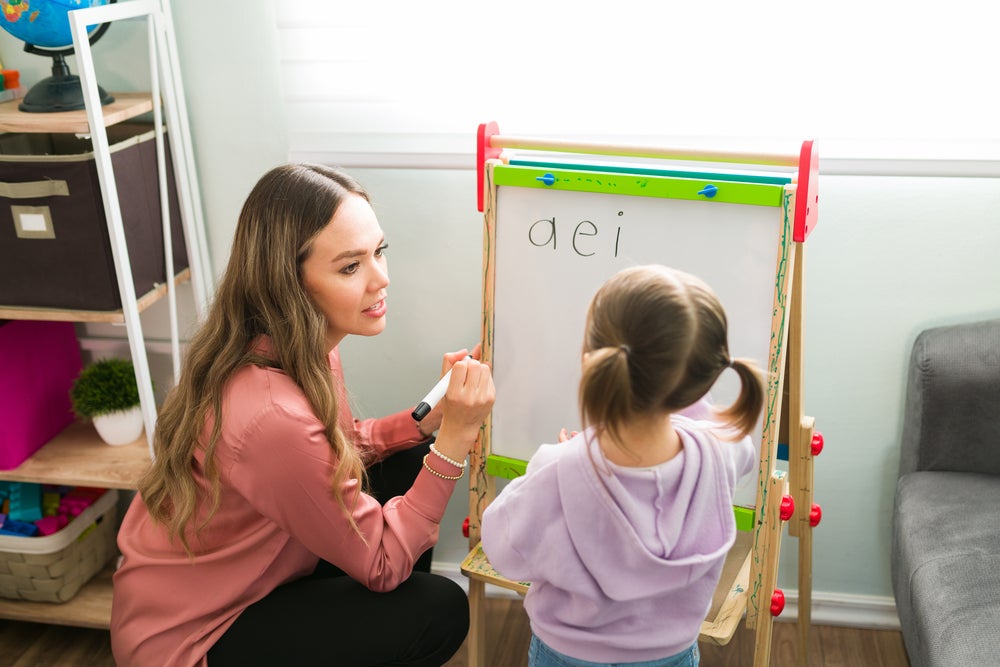Teaching vowels to kids—especially long and short vowel sounds—can be tough. But understanding vowels helps us learn to read and spell—essential Core Skills, part of the 5 C’s at the heart of the Begin Approach to helping kids thrive in school and life.
Kids with strong Core Skills do better in school, so it’s worth pushing through the challenge of vowels to help kids understand them. Curious how you can help? We’ve got you covered!
The Short Cut
- Kids are ready to learn about vowels when they can hear vowel sounds within a word
- Short vowel sounds (like the a in “bat” or the o in “top”) occur in simple words, so they’re a good place to start
- Long vowel sounds (vowels that sound like their name, like the a in “bake”) need more explanation and are best for kids who’ve already learned short vowels
- Teaching vowels can be fun! You can tap into kids’ natural love of play with vowel games so it doesn’t feel like a chore
What Makes Vowel Sounds Hard for Kids
Most kids pick up consonant pronunciations much more quickly than vowels. Why is that?
One of the challenges with vowel sounds is that they can’t exactly be “felt” in the mouth. With consonants, kids can feel the friction created while using their tongue, lips, or teeth to produce the sounds. To produce a vowel sound, you only need to adjust the shape of your mouth.
Then there’s the challenge of distinguishing between long and short vowels or two similar vowel sounds. In a nutshell, learning vowels can be tough!
But have no fear; we’re here to help! We’ve compiled a step-by-step guide you can use to help your child finally connect the dots with both short and long vowel sounds.
When Is Your Child Ready to Learn Vowels?
It’s challenging to teach your child vowel sounds if they can’t identify them. So one of the most important signs that a child is ready to learn vowel sounds is when they can hear the vowel sounds in simple words.
For instance, let’s say your child tries to spell a simple CVC (consonant, vowel, consonant) word like “cat.”
Even if they misspell the word by writing “cet” instead of “cat,” this is still a moment to celebrate because it indicates that your child can hear that there’s a letter between the C and the T.
Once you think your child is developmentally ready to start learning more about vowels, you can move on to short vowel sounds.
Tips for Teaching Short Vowel Sounds
Since words with short vowels are spelled more consistently than words with long vowels, they’re a great place to start when teaching vowel sounds to kids.
1. Begin with the Names of the Vowels
Teaching kids A, E, I, O, U (and sometimes Y) is the first step in familiarizing them with vowels. We recommend taking it one vowel at a time to avoid overwhelming them.
The good news is that there are various tactics you can use to help kids remember their vowels.
Besides sounding them out, you can also help your child create three-dimensional letters with something as easy and accessible as play dough. To help emphasize the differences between the letters, use a different color for each vowel.
As kids feel and create vowels, more of their senses will be engaged, and this will help them get familiar and comfortable with the five vowels and their sounds.
2. Differentiate between the Vowels
This point on our list is connected to the previous one. Still, it deserves its own emphasis because it can be easy for kids to struggle with differentiating between the vowels.
The example we used earlier of a kid spelling “cat” as “cet” is common because the sounds are so similar to each other. This is why it’s important to emphasize that the letters are distinct.
To add some fun into your child’s learning, you might consider using stick puppets made with the five vowels. Simply attach a printout of each letter onto a popsicle stick, and then let your imagination run wild as you give them personalities and adventures!
A can go to the store with E, I can head out to the beach with O, and so on. While acting out your scenes, remember to emphasize the differences between the letters and keep sounding the vowels out clearly.
3. Introduce Word Families for Simple CVC Words
Word families are groups of words that have a common pattern or features. Helping children learn these allows them to spell and sound out related words.
For example, a child who learns the word family -at will have an easier time spelling cat, mat, hat, etc.
Remember to take it one word family at a time. This will help prevent your child from feeling overwhelmed with all the new information.
We recommend these activities for working on word families:
- Say a word like “hat” and ask if it has the /a/ sound or the /i/ sound. Focus on sounding the letters out, not writing them, so your child can hear the differences better.
- Say two words and ask which has /o/ as the middle sound.
- Make a Tic-Tac-Toe board and put a vowel in each square. As you play, ask your child to identify the vowel with its short sound before placing their mark in a square.
- Sound out CVC words by emphasizing the phonemes. For example, say /t/…/a/…/p/… and then blend the sounds together into tap.
- Place a t and a p with a space in between. Ask your child to fill in the missing letter that will form “top.”
- Switch the vowels. For this, you can play with magnetic letters. Ask your child to turn “tap” to “tip” and then to “top.”
Here are some great words with short vowel sounds to practice at home:
Short “A” Sound Examples
- Cap
- Bat
- Bad
- Cat
- Dad
- Lap
- Tap
Short “E” Sound Examples
- Bed
- Get
- Pen
- Bet
- Wet
- Fed
- Net
- Ten
Short “I” Sound Examples
- Bin
- Sip
- Tip
- Zip
- Did
- Fit
- Nip
- Win
Short “O” Sound Examples
- Rod
- Cod
- Jog
- Dot
- Fog
- Mop
- Pot
- Top
Short “U” Sound Examples
- Bun
- Cut
- Pup
- Sun
- Mud
- Run
- Fun
- Hug
Tips for Teaching Long Vowel Sounds
1. Form Long Vowel Sounds
Although long vowel sounds are typically easier for kids to learn, we normally teach short vowels first. Why is that? It takes two vowels to make a long sound, and this can be tricky for kids to understand at first.
To get started with long vowel sounds, we begin teaching the silent e. It’s important for kids to understand that every vowel will change its sound when a silent e is put after the CVC form of a word.
For instance, if you put an e after the CVC word tap, the word changes to tape, and the vowel sound produced changes.
To help your child grasp this concept, begin with phonemic awareness. Ask them:
- Are tap and tape the same?
- Say the individual sounds slowly—t-a-p and t-ae-p.
- What changed?
2. Demonstrate with Manipulatives
You can also use magnetic letters and flip cards to help illustrate the power of the silent e.
First, show your child the letter a. Make the short sound and then explain that you will give the power to its own name. Who can give the power? E! Tap the magnetic e on the magnetic a, adding it to the end of the word after, and—voila!—you now have a new word.
Using magnetic letters, you can change tap to tape, bit to bite, dot to dote, and so on. Your child will hear that the sound changes, and using magnetic letters will help them see which vowel contributes to the change in sound.
You can also use flip cards to demonstrate this concept. Fold the last eighth or so of an index card, and then write a CVC word, like tap, on the unfolded part and an e on the folded part. When you unfold the card, the word will change from tap to tape!
Note: The long o and u sounds can be a bit more complicated, so we recommend holding off on those until your child has gotten a good grasp on the others.
3. Correct the Spelling
At Begin, we’ve seen firsthand how tapping into the power of play helps kids with literacy. To help your child gain a better understanding of long vowel sounds, why not play a game to strengthen their knowledge?
To play this game, show your child the incorrect spelling of a CVC word and have them correct it. For example, using magnetic letters, spell out f-i-n-o but pronounce it as fine. Now your child, who’s learned the power of the silent e, will be able to replace the o with an e.
Here are some great words you can use for this activity:
Long “A” Sound Examples
- Bake
- Lake
- Fame
- Date
- Fate
- Cake
- Make
Long “I” Sound Examples
- Hide
- Fine
- Time
- Line
- Mine
- Pine
- Wife
- Ride
Long “O” Sound Examples
- Joke
- Rose
- Woke
- Poke
- Cone
- Bone
- Hope
- Hole
- Nope
- Rope
Learning Vowels with Begin
Learning vowels can be challenging for kids, but it’s an essential part of developing their Core Skills. Playful learning activities are the key to solving that problem—taking what a kid might see as a difficult task and making it a game!
Our award-winning, kid-safe, ad-free HOMER app does exactly that. It’s full of engaging games for kids that teach them the building blocks of literacy—just 15 minutes a day has been proven to raise early reading scores by 74%!
Help your child learn their basic vowels, start with the short CVC words, and then after some practice, help them nail the long vowel sounds. And remember, if you need a little help, we’re here for you.













